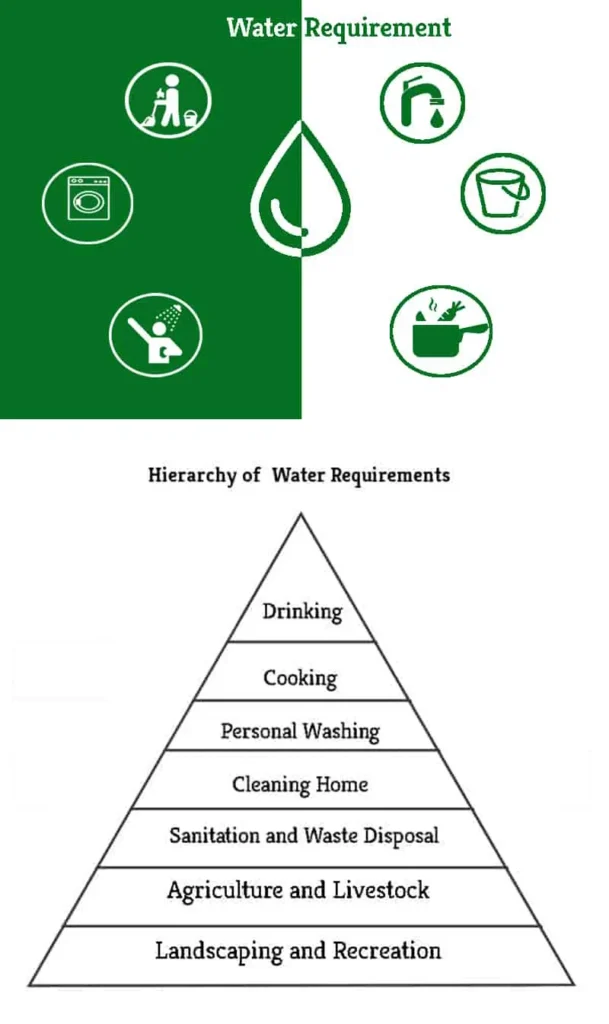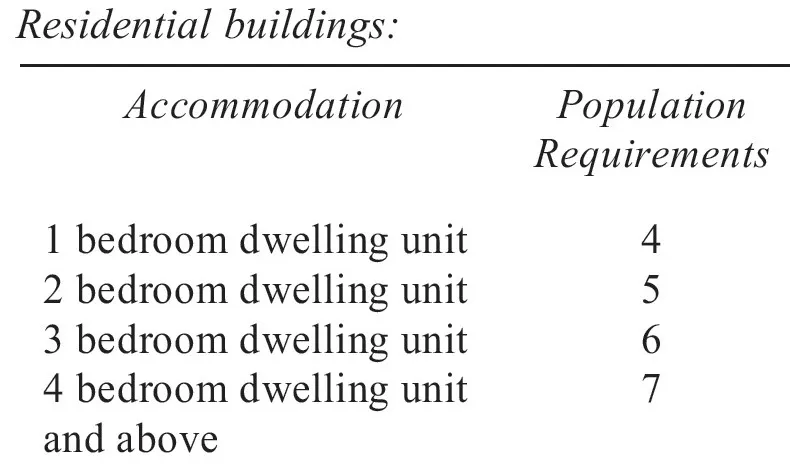If you want to know about the rainwater disposal system or rainwater harvesting system or principles of water supply, please click the link.
The water supply requirements for a building can vary depending on the size, purpose, and location of the building, as well as local building codes and regulations.

- The total quantity of water per day is estimated based on the proposed occupancy and activities catered.
- Population for each type of building shall be estimated on the basis of information obtained from the users. Alternatively, population may be worked on the following basis, for different type of buildings

Notes
- The above figures consider a domestic house hold including support personnel, wherever applicable.
- For plotted development, the population may be arrived at after due consideration of the expected number and type of domestic household units.
- Dwelling unit under EWS category shall have population requirement of 4 and studio apartment shall have population requirement of 2.

Notes
- Wherever there are multiple work shifts, the number of users within a 24 h period may be considered as per actuals.
- Population of 5 to 15 percent, depending on the usage of building, shall be considered for visitors and floating population likely to use the buildings facilities.
1) Water supply requirements as per NBC
The National Building Code (NBC) of India lays down the requirements for water supply in buildings. The following are some of the key provisions of the NBC related to water supply:
i) For residences
- A minimum of 70 to 100 litre per head per day may be considered adequate for domestic needs of urban communities, apart from non-domestic needs as flushing requirements (which varies based on type of building occupancy).
- As a general rule the following rates per capita per day may be considered for domestic and non-domestic needs
- For communities with population up to 20 000…… (a) Water supply through stand – 40 lphd (Min) post (b) Water supply through house – 70 to 100 lphd service connection
- For communities with: 100 to 135 lphd population 20000 to 100000 together with full flushing system
- For communities with population: 150 to 200 lphd above 100000 together with full flushing system
Note – The value of water supply given as 150 to 200 litre per head per day may be reduced to 135 litre per head per day for houses for Medium Income Group (MIG) and Lower Income Groups (LIG) and Economically Weaker Section of Society (EWS), depending upon prevailing conditions and availability of water.
- Out of the 150 to 200 litre per head per day, 45 litre per head per day may be taken for flushing requirements and the remaining quantity for other domestic purposes.
- Water Supply for Buildings Other than Residences Minimum requirements for water supply for buildings other than residences shall be in accordance with Table below.
- The water demand for the laboratory facilities will depend on actual requirements based on functional point of view.
ii) For other than residences

Notes
- For calculating water demand for visitors, consumption of 15 litre per head per day may be taken.
- The water demand includes requirement of patients, attendants, visitors and staff. Additional water demand for kitchen, laundry and clinical water shall be computed as per actual requirements.
- The number of persons shall be determined by average number of passengers handled by stations, with due considerations given to the staff and vendors who are using these facilities.
- Consideration should be given for seasonal average peak requirements.
- The hospitals may be categorized as Category A (25 to 50 beds), Category B (51 to 100 beds), Category C (101 to 300 beds), Category D (301 to 500) and Category E (501 to 750 beds).
2) Water supply requirements of traffic terminal stations
- The water supply requirements of traffic terminal stations (railway stations, bus stations, harbours, airports, etc) include provisions for waiting rooms and waiting halls. They do not, however, include requirements for retiring rooms.
- Requirements of water supply for traffic terminal stations shall be as per Table above.
3) Water supply for other purposes
- Water supply in many buildings is also required for many other applications other than domestic use, which shall be identified in the initial stages of planning so as to provide the requisite water quantity, storage capacity and pressure as required for each application.
- In such instances information about the water use and the quality required may be obtained from the users.
- Some typical uses other than domestic use and fire fighting purposes are air conditioning, swimming pools and water bodies, and gardening.
- Treated water from sewage treatment plant, with suitable tertiary treatment, should be used for flushing
purpose (with dual piping system), gardening purpose, cooling tower make up, and/or for other non potable usage. - The water demand for landscaping purposes is generally taken as 6 to 8 litre/m2/day for lawns. For shrubs and trees the above value can be reduced considerably.
It’s important to consult local building codes and regulations to determine the specific water supply requirements for a building in a particular area.